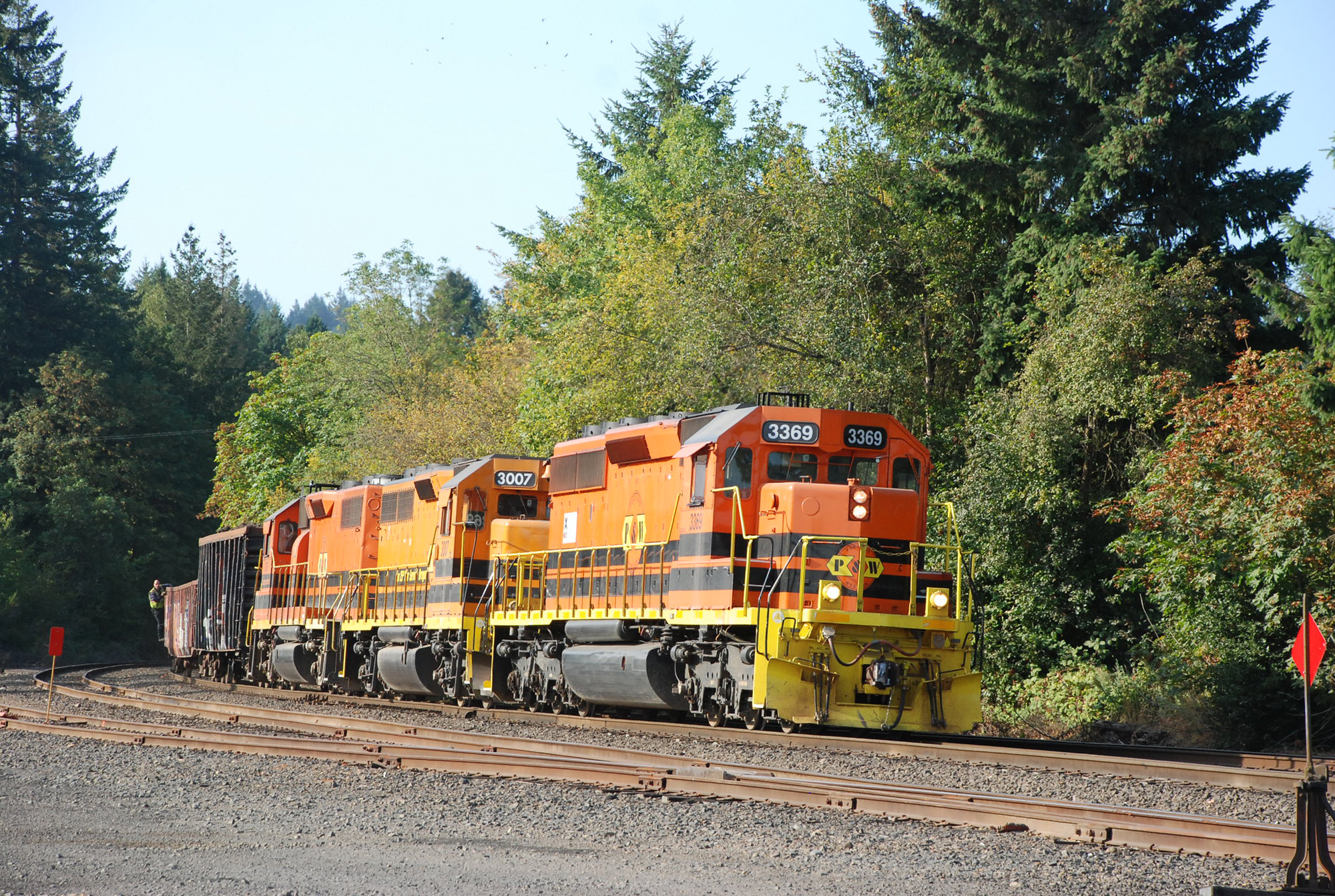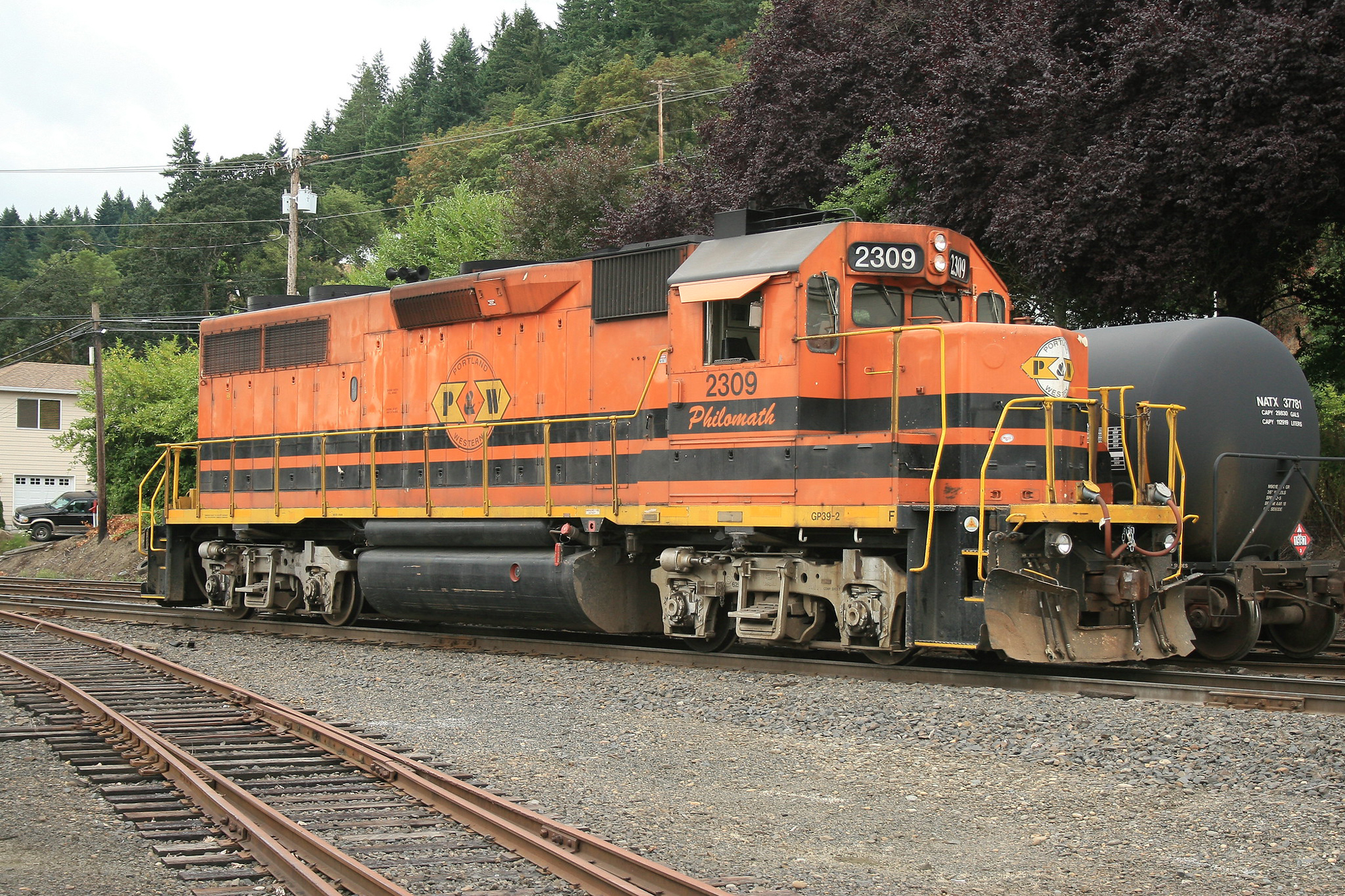Portland and Western Railroad: Roster, Overview, Photos
Published: January 13, 2025
By: Adam Burns
The Portland and Western Railroad (PNWR) - a Genesee & Wyoming property - is an essential component of the freight transportation network in the Pacific Northwest.
The railroad, a Class II regional, spans 520 miles and is fully contained within Oregon. PNWR also incorporates the Willamette & Pacific Railroad (WPRR) as part of its operations.
Its network travels from Astoria to Portland along the scenic Columbia River, stretches through the heart of the Willamette Valley from Portland to Eugene, and includes various branches running through the Northern Oregon Coast Range.
The PNWR has played a critical role in supporting regional industries and connecting communities. This article provides a detailed exploration of the PNWR's history, operations, economic impact, and future prospects.
 Portland & Western SD40-2 #3369, along with a pair of GP40s, pause to work the junction at Whiteson, Oregon on August 17, 2018. Doug Kroll photo.
Portland & Western SD40-2 #3369, along with a pair of GP40s, pause to work the junction at Whiteson, Oregon on August 17, 2018. Doug Kroll photo.Historical Background
The roots of the Portland & Western can be traced back to the early 1990s. Founded in 1993 as the Willamette & Pacific Railroad, PNWR has been a subsidiary of Genesee & Wyoming since 1995.
The railroad's formation through acquisition of former Southern Pacific branch lines. Among these were the Toledo Branch stretching from Albany to Toledo and the Westside Branch reaching from Monroe to St. Joseph, close to McMinnville.
Other lines included the Bailey Branch extending west from Monroe to a sawmill, the Dallas Branch from Gerlinger to Dallas, the Willamina Branch from Whiteson near Amity to Willamina, and the southern Newberg branch from St. Joseph to Springbrook, just north of Newberg.
These lines primarily transport lumber, paper, and some agricultural products from various shippers. Notably, the Cascade Steel Rolling Mill in McMinnville represents a key shipper, with propane shipments managed by several suppliers.
The P&W aimed to preserve crucial rail services for local industries in this region while enhancing efficiency through more localized management.
In 1995, the Portland & Western was formed to manage the remaining SP branch lines in Oregon. These included the former Tillamook Branch running from Willsburg Junction near Milwaukie to Hillsboro, the Westside–Seghers Branch from Hillsboro to Seghers near Gaston, and the remaining portion of the Newberg branch between Cook and Springbrook.
The Willamette & Pacific utilizes trackage rights on the Newberg branch and a section of the Tillamook Branch connecting Cook and Willsburg Junction, along with rights on a short segment of the SP's mainline to Brooklyn Yard, enabling interchange with Union Pacific.
The P&W officially began service on August 18, 1995, initially covering 52 miles of leased SP trackage. Shortly afterwards, the Burlington Northern, transferred portions of its ex-Oregon Electric Railway branch lines north of Salem to the new short line, including the Forest Grove branch.
Today, operations on most former SP branches are maintained under a twenty-year lease, now overseen by Union Pacific. The former BN branches operate under a combination of leases and straightforward ownership agreements.
Operations and Infrastructure
The Portland & Western - operating 20 to 30 trains per day - serves a diverse range of customers and industries, including lumber, agriculture, metal, and automotive sectors. The rail line primarily operates in the Willamette Valley and extends its network through connections in surrounding regions.
Economic Impact
The Portland and Western is instrumental in the economic vitality of the region it serves. Its primary traffic consists of:
- **Lumber and Forest Products**: Given Oregon's extensive forest resources, the transportation of lumber and other forest products is a significant aspect of railroad's operations.
- **Agriculture**: Oregon is known for its diverse agricultural output, including fruits, vegetables, grains, and dairy products.
- **Manufacturing and Heavy Industries**: The transportation of raw materials and finished products for manufacturing industries is critical to maintaining the region’s industrial base.
In addition to supporting these sectors, the PNWR is a significant employer in the region, providing jobs that range from railroad operations to logistical planning and maintenance.
Diesel Roster
| Model Type | Road Number | Builder | Completion Date | Serial Number | Notes |
|---|---|---|---|---|---|
| RP4ED (Norfolk Southern) | 101-102 | EMD | 7/1961 | 26786, 26795 | 101 scrapped; ex-W&P 101-102; NS 9738, 9728 (rebuilt as hump engines); built as N&W GP18 943, 956 |
| SW1200m | 1201 | EMD | 10/1953 | 18861 | ex-Rail Link 1201; ex-W&P SW1200m 1201; built as Pittsburg & Shawmut SW9 232 |
| SD7 | 1501 | EMD | 11/1952 | 17145 | Retired; ex-W&P 1501; ex-SP 1539/1401/2701; built as SP 5280 |
| SW1500 | 1551 | EMD | 12/1969 | 35293 | ex-G&W 47; built as Houston Belt & Terminal 50 |
| SW1500 | 1552 | EMD | 1/1970 | 35792 | Renumbered from 41; ex-I&M 41; built as SP 2556 |
| GP9 | 1801 | EMD | 4/1959 | 25130 | ex-W&P 1801; ex-SP 3855 (2nd)/3693; built as SP 8830 |
| GP9 | 1802 | EMD | 7/1956 | 22075 | Off Roster. ex-W&P 1802; ex-Austin & Northwestern 44; ex-Kyle Railroad 5944; built as Rio Grande 5944 |
| GP9 | 1803 | EMD | 1/1957 | 22920 | ex-Louisiana Delta 1752; ex-SP 5790/3579; built as SP 5738 |
| SD9 | 1851 | EMD | 4/1954 | 19449 | ex-SP 4326/3819; built as SP 5360 |
| SD9 | 1852 | EMD | 5/1955 | 20216 | Off roster. ex-W&P 1852; ex-SP 4397/3916; built as SP 5438 |
| SD9m | 1853 | EMD | 1/1953 | 17157 | Rebuilt as SD9m by SP; ex-SP 1532/1402 (2nd)/2709; built as SP SD9 5288 |
| SD9 | 1854 (2nd) | EMD | 4/1955 | 20204 | ex-Lavacot Locomotive Works 4433; ex-Willamette Valley 4433; ex-SP 4433/3904; built as SP 5426 |
| SD9 | 1854-1855 | EMD | 11/1955 | 20693, 20695 | ex-W&P 1854-1855; built as Chicago & Illinois Midland 52, 54 |
| GP38m | 2005 | EMD | 12/1963 | 28467 | ex-Utah Railway 2505; ex-SP GP35E 6526; built as SP GP35 7414 |
| GP38m | 2152 | EMD | 12/1970 | 36694 | ex-GMTX 2683; built as B&O 4818 |
| GP39-2 | 2301-2317 | EMD | 8/1974 | 74602-1 thru 74602-17 | ex-AT&SF 3100-3116; built as AT&SF 3600-3616 |
| GP40P-2 | 3001-3002 | EMD | 8/1967, 9/1967 | 33269, 33273 | Paired with slugs. 3001 scrapped; ex-NS 1377/1382; built as N&W GP40 1377, 1382 |
| GP40 | 3003-3004 | EMD | 1/1967 | 32606-32607 | ex-LLPX 3203-3204; ex-EMD Leasing 200-201; ex-GO Transit 725-726; built as Rock Island 3004/380; 3000/381 |
| GP40 | 3005-3006 | EMD | 1/1967 | 32607, 32600 | ex-LLPX 3205-3206; ex-EMD Leasing 202, 205; ex-GO Transit 720-721; built as Rock Island 3005/374, 3002/375 |
| GP40 | 3007 | EMD | 1/1967 | 32603 | ex-LLPX 3211/4401; ex-EMD Leasing 206; ex-GO Transit 723; built as Rock Island 3001/377 |
| SD40M-2 | 3051 | EMD | 1/1069 | 34576 | ex-Kansas City Southern 612 (2nd); built as C&NW SD45 943 |
| SD40M-2 | 3052 | EMD | 1/1070 | 35754 | Renumbered 3603. ex-Buffalo & Pittsburgh 450; built as St. Louis Southwestern/SP SD45 9153 |
| SD40-3 | 3300 | EMD | 8/1978 | 776098-7 | Rebuilt from SD40T-2; ex- Missouri & Northern Arkansas 4076; ex-UP 8585/4015; built as Rio Grande 5392 |
| SD40-3 | 3369 | EMD | 7/1978 | 776057-20 | Rebuilt from SD40-2; ex-HLCX 7839; ex-BNSF 7839; built as BN/C&S 7839 |
| GP38-2 | 3532 | EMD | 1/1973 | 71702-3 | Off property, transferred to Arizona Eastern. ex-HLCX 1829; ex-UP 349; ex-MP 2076; built as MP 925 |
| GP38-2 (EMD) | 3570 | EMD | 10/1972 | 72604-3 | Off property, transferred to Arizona Eastern. ex-HLCX 3866; ex-UP 492/1992; ex-CSX 2602; ex-Seaboard System 4092; built as L&N 4092 |
| SD45-2 | 3601 | EMD | 2/1967 | 32776 | ex-I&M Rail Link 462; ex-HATX 462; ex-Huron Central 462 < ex-SP SD45R 7496; built as SP SD45 8862 |
| SD45-2 | 3602 | EMD | 6/1967 | 32842 | ex-I&M Rail Link 463; ex-HATX 463; ex-Huron Central 463; ex-Buffalo & Pittsburgh 498; ex-SP SD45R 7498; built as SP SD45 8928 |
| SD45-2 | 3604 | EMD | 5/1968 | 33662 | Renumbered from 3053. ex-I&M Rail Link 456; ex-HATX 7565; ex-SP SD45R 7565; built as SP SD45 8973 |
Conclusion
The Portland and Western is more than just a transportation service; it is a lifeline for the communities and industries it serves in the Pacific Northwest.
Through its rich history, robust operations, and commitment to sustainable practices, PNWR has established itself as a pivotal figure in the region's economic landscape.
Recent Articles
-
California Christmas Train Rides In Felton!
Nov 25, 25 12:48 PM
The Santa Cruz Holiday Lights Train offers a dazzling nighttime experience that transforms downtown Santa Cruz into a rolling festival of lights, music, and holiday spirit. -
Alabama Christmas Train Rides In Calera!
Nov 25, 25 11:45 AM
If you’re considering a holiday outing that blends nostalgia, sparkle, and simple together time, the Heart of Dixie’s Christmas trains are hard to beat. -
Wisconsin Christmas Train Rides In East Troy!
Nov 25, 25 11:39 AM
When the holidays arrive, the museum becomes a festive favorite thanks to its Christmas Trains, a family tradition that pairs small-town warmth with the magic of an old-fashioned trolley ride.




